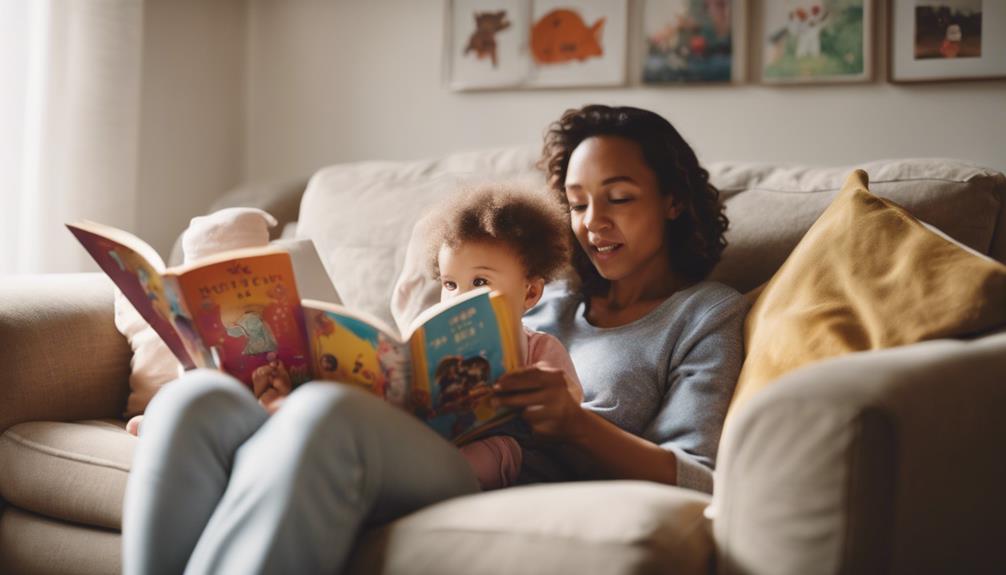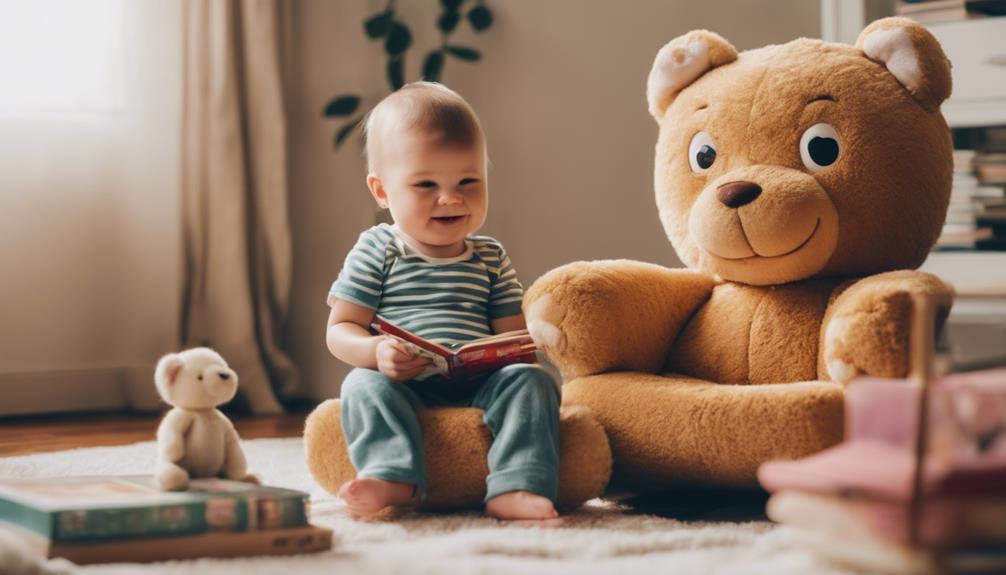When it comes to your baby’s reading milestones, here’s what to expect: From 3-4 months, they’ll start making sounds. At 9-12 months, they’ll copy simple words. Around 13-16 months, they repeat sounds from books. By 17-22 months, they fill in missing words. At 23-24 months, they name colors in books. Encourage pointing to boost cognitive skills. Babbling helps build language abilities. Mimicking reading behaviors fosters early literacy. From 4-6 months, they enjoy touching books. By 9-12 months, interactive board books are a hit. Let your child pick favorites and imitate sounds. Keep exploring for more insights.
Key Takeaways
- Babies start pointing to pictures in books around 9-12 months, enhancing visual recognition skills.
- Toddlers imitate sounds and point to favorite pictures, showing early language development.
- Children point to major body parts in pictures at 17-22 months, improving cognitive abilities.
- Toddlers identify colors in books at 23-24 months, indicating advanced language comprehension.
- Encouraging facial expressions enhances picture recognition skills in babies and toddlers.
Language Absorption in Infants
Infants absorb language naturally through interactions with their environment, including facial expressions, sounds, and words. This early literacy development is essential for their future reading and comprehension skills.
From a young age, babies focus on sounds, objects, and faces to grasp meaning and begin building their language repertoire. By the time they reach one year old, many infants can already comprehend dozens of words and may even start vocalizing themselves.
Encouraging language development in infants is important for fostering their literacy skills in the future. Reading to babies not only enhances their language comprehension but also boosts their cognitive development.
Through exposure to words, stories, and conversations, infants begin to form connections and understand the world around them. By engaging with your baby through language-rich interactions, you're laying a strong foundation for their future literacy success.
Vocalization and Word Recognition

As babies progress in their early literacy journey, their vocalization skills and word recognition abilities become increasingly apparent. Around 3-4 months old, babies typically start vocalizing sounds like 'ba-ba' or 'da-da' as they explore their developing abilities.
By 9-12 months, you may notice your little one imitating simple words they hear during reading sessions. As toddlers reach 13-16 months, they might repeat sounds or words they recognize from their favorite books.
Between 17-22 months, children may surprise you by filling in missing words in familiar stories, showing a growing grasp of language. Finally, by 23-24 months, kids begin identifying and naming colors they see in books, demonstrating expanding word recognition skills.
Encouraging and engaging with your child during these stages can further enhance their vocalization and word recognition capabilities, setting a strong foundation for their future literacy development.
Exploring Books and Pictures
When it comes to exploring books and pictures with your baby, there are key points to keep in mind:
- Book interaction techniques
- Picture recognition skills
- Storytime engagement tips
These aspects play an essential role in your baby's development of language, cognitive abilities, and a lifelong love for reading.
Encouraging your little one to interact with books and explore pictures won't only enhance their learning but also create special bonding moments during storytime.
Book Interaction Techniques
Explore books and pictures with your baby by engaging them in interactive reading sessions. Use different book interaction techniques to enhance your baby's reading experience. Here are some techniques you can try:
| Technique | Description | Age Range |
|---|---|---|
| Pointing and Naming | Point to objects in the pictures and name them aloud. | 9-12 months |
| Sound Imitation | Encourage your baby to imitate sounds or words in the book. | 9-12 months |
| Interactive Books | Choose books with flaps or textures for tactile exploration. | 9-12 months |
These techniques help babies between 9-12 months engage more actively with books, promoting their reading skills. By incorporating these methods into your reading sessions, you can make the experience more enjoyable and beneficial for your little one.
Picture Recognition Skills
Engage your baby in exploring books and pictures to develop their picture recognition skills. Around 9-12 months, babies start pointing to pictures in books and imitating sounds or simple words.
As they grow, toddlers aged 13-16 months select their favorite books, imitating animal sounds while pointing to pictures they like.
By 17-22 months, children can point to major body parts in pictures and follow short storylines.
At 23-24 months, toddlers can identify colors in books, memorize parts of favorite books, and enjoy story time at the library.
As toddlers progress, they begin making comments about what they see in books, filling in missing words in familiar stories, and turning pages one by one.
Encourage your child to explore books with various facial expressions to enhance their picture recognition skills and foster a love for reading.
Storytime Engagement Tips
Encourage babies to interact with books by actively exploring the pictures and textures within them. Reading aloud to your little one not only fosters a love for books but also aids in their cognitive development. Start by allowing your baby to touch, hold, and even put the book in their mouth. Introducing textured books, such as ones with rough or fuzzy surfaces, can engage their sense of touch and make storytime more interactive.
Around 7-8 months, babies begin to grasp books, touch pictures, and show interest in facial expressions within the pages. As your baby grows to 13-16 months, they may start imitating animal sounds, pointing to favorite pictures, and enjoying interactive books that require their participation.
Beginning Sound Awareness

Developing beginning sound awareness is essential for helping babies recognize and repeat sounds in words. Here are some tips to help enhance your baby's sound awareness:
- Imitate Sounds: Encourage your baby to imitate sounds and simple words they hear while reading. This can help them become more familiar with different sounds and how they form words.
- Animal Sounds: Incorporate animal sounds into your reading routine. Encourage your baby to identify and mimic animal sounds as part of their sound awareness development. This can be a fun and engaging way to enhance their understanding of sound variations.
- Fill in Missing Words: As your baby grows older, around 13-16 months, they may start filling in missing words in familiar books. This is a sign that they're beginning to understand the connection between sounds and words, further developing their sound awareness skills.
Pointing to Objects in Books

Around 17-22 months of age, toddlers typically begin pointing to major body parts depicted in books, indicating a growing ability to connect real-life objects with their representations in pictures. This milestone is a significant step in cognitive development as it shows that your child is starting to understand visual cues and make connections between images and the real world.
By pointing to objects in books, your toddler isn't only engaging with the content but also laying the groundwork for language development and communication skills. This action demonstrates their interest in the book's content and their ability to interact with it actively. Encourage this behavior by discussing the objects they point to, naming them, and asking questions. These interactions can further enhance their understanding and vocabulary.
Pointing to objects in books is a positive sign that your child is progressing in their cognitive abilities and preparing themselves for more advanced reading milestones ahead.
Recognizing Familiar Words

By the age of 23-24 months, toddlers often begin identifying familiar words in books, marking an important step in their early literacy journey.
Here's what recognizing familiar words can mean for your little one's language development:
- Building Early Literacy Skills: Recognizing familiar words is a vital aspect of language development for toddlers. It signifies that they're starting to understand the connection between spoken and written language.
- Enhancing Reading Readiness: When toddlers point out familiar words in books, it shows that they're progressing towards being ready for reading. This skill helps lay the foundation for future reading abilities.
- Boosting Confidence and Interest: As toddlers become adept at recognizing familiar words, they often gain confidence in their abilities. This newfound confidence can spark an interest in reading and further encourage language development in young children.
Babbling and Storytelling

Begin engaging with your baby's babbling and storytelling abilities as early as 3 months to foster their language development. Babbling is a significant milestone that typically emerges around this age. It involves your baby making various sounds and experimenting with different vocalizations. This early form of communication sets the stage for future language skills and storytelling capabilities.
To help you understand the importance of babbling and storytelling in your baby's development, here's a table highlighting key points:
| Benefits of Babbling | Enhancing Storytelling Skills |
|---|---|
| Develops vocal abilities | Encourages interactive dialogue during reading |
| Fosters communication skills | Responding to baby's babbling can strengthen language development |
| Forms the foundation for language acquisition | Establishes a connection between sounds and meanings |
As your baby grows and starts babbling more frequently, take the opportunity to engage in storytelling moments that can further nurture their language and communication abilities.
Imitating Reading Behaviors

When babies imitate reading behaviors, they often mimic turning pages, pointing at pictures, and babbling as if reading aloud.
Encouraging this imitation by providing age-appropriate books helps build early literacy skills and a love for reading.
Mimicking Book Handling
Imitating reading behaviors, such as mimicking book handling, is a significant indicator of a baby's early interest in storytelling and reading. When your little one starts to imitate flipping pages, holding books, or babbling while looking at pictures, it's a heartwarming sign of their budding curiosity about books.
Here's what to expect during this stage of your baby's reading journey:
- Observing Adults: Babies often learn by watching adults. When they see you flipping through pages or reading aloud, they may imitate these actions with their own books.
- Positive Association: Encouraging your baby to handle books gently and explore them freely can create a positive association with reading, making it a fun and enjoyable activity.
- Cognitive Development: Mimicking book handling is a natural part of your baby's cognitive and language development. It helps them understand the concept of books and sets the foundation for future literacy skills.
Pretend Reading Aloud
During playtime, your baby may engage in pretend reading aloud by babbling or repeating sounds while looking at books. This behavior typically emerges around 9-12 months as your little one starts to imitate reading actions they've observed.
As your baby approaches 13-16 months, you might notice them pretending to read aloud by flipping through books and pointing at pictures, showing an increased interest in storytelling. By 17-22 months, children may even begin to fill in missing words in familiar books during these pretend reading sessions, displaying early signs of language comprehension.
Around 23-24 months, toddlers may take their pretend reading a step further by memorizing and reciting simple parts of their favorite stories, showcasing their growing love for books. Through these pretend reading moments, your child isn't only developing essential literacy skills but also fostering a strong connection to the magical world of storytelling.
Pointing at Words
Encourage your baby to start pointing at words as they explore books and develop early literacy skills. This milestone, known as Pointing at Words, is an exciting step in your baby's reading journey.
Here's what to expect:
- Sign of Early Literacy: Around 12-18 months of age, babies may begin imitating reading behaviors by pointing at words. This action shows an emerging interest in books and language.
- Understanding Word Meaning: Pointing at words signifies that babies are starting to grasp that words convey meaning and are essential in the reading process. It showcases their cognitive development.
- Building Language Skills: Encouraging your baby to point at words while reading can enhance their vocabulary and language skills. This activity can lead to the recognition of familiar words and lay the foundation for future reading abilities.
Matching Words to Objects

By pointing to objects in books when caregivers name them, toddlers between 12-18 months start matching words to objects, showing early signs of developing language and cognitive skills. This milestone is important as it indicates a toddler's ability to comprehend language and connect words with real-world items.
When toddlers point to objects in books and hear the corresponding words from caregivers, they begin to understand the relationship between language and the objects they see. Encouraging toddlers to repeat these words associated with objects further supports their language development.
Matching words to objects is an essential step in a child's language acquisition journey. It not only enhances their vocabulary but also lays the foundation for reading comprehension in the future. As toddlers engage in this activity, they're actively building connections in their brains that aid in cognitive development.
Providing opportunities for toddlers to match words to objects is beneficial for their overall language and cognitive growth.
Early Reading Engagement

Engaging with books from an early age is vital for fostering a love for reading and developing foundational literacy skills in young children. Early reading engagement plays an essential role in your child's development.
Here are three key aspects to take into account:
- Exploring Textures: From 4-6 months, babies enjoy touching books and feeling different textures. This exploration aids in fine motor skill development, laying the groundwork for future reading abilities.
- Interactive Board Books: Between 9-12 months, babies start repeating sounds they hear while reading and show a preference for interactive board books. These books help keep your child engaged and excited about reading.
- Choosing Favorites: Toddlers aged 13-16 months begin choosing favorite books and imitating animal sounds they encounter in stories. This stage marks the beginning of a child's personal connection to reading, setting the stage for a lifelong love of books.
Frequently Asked Questions
At What Age Should Babies Be Read To?
You should start reading to babies from birth. It helps with bonding, cognitive development, and language skills. Even at 3 months, they benefit from hearing you read. Regular reading sessions enhance their vocabulary and set the stage for a love of books.
What Is the Age Milestone for Reading?
You can expect reading milestones to start around ages 3-4. Children begin connecting spoken language with written text, identifying rhyming words and syllables. By 4-5, they decode simple words, recognize letters, and engage with complex stories.
What Age Is a Child Expected to Read?
You're expected to start reading around ages 5-7, but every child is unique. By 4-5, you'll likely recognize letters, sounds, and simple words. At 3-4, connecting spoken words with text and identifying rhymes is common.
What Are the Five Stages of Literacy Development?
You are expected to develop literacy through five stages: emergent, beginning, developing, expanding, and bridging. Each stage builds upon the last, focusing on language skills, decoding, fluency, comprehension, advanced reading, and critical thinking.
Conclusion
To sum up, as your baby continues to reach reading milestones, remember that every child develops at their own pace. Keep encouraging their curiosity and love for books, and soon enough they'll be reading on their own!
Just remember, Rome wasn't built in a day – so don't rush the process. Enjoy the journey of watching your little one grow into a bookworm!










